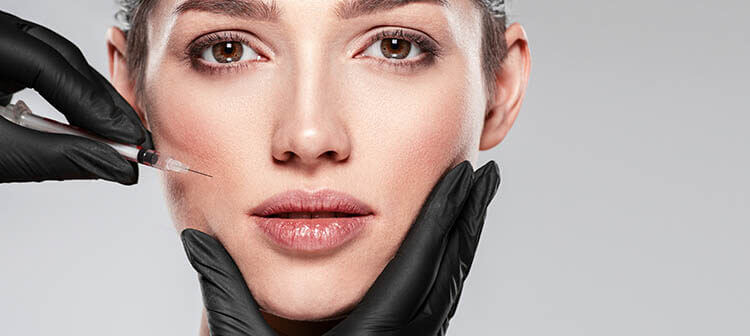The popularity of injectable dermal fillers continues to skyrocket as more of us begin to appreciate their versatility as a minimally invasive procedure. We know they can enhance the chin or jawline, smooth the hollows beneath the eyes, plump up pouts, fill facial folds and restore the rounded youthful contours of the cheeks and our senior nurse Suzi often uses dermal fillers to lift the mid-face and open up the mouth area.
Now a new study has quantified just how much dermal fillers can lift as well as fill – and even discovered they create a “small, but significant” boost where you may not be expecting it.
Researchers at the Mayo Clinic in the US designed a study to measure the lifting effect of soft tissue fillers in different areas of the face and their results were recently published in the May issue of Plastic and Reconstructive Surgery journal.
The non-surgical facelift?
Injections of dermal fillers were made in the key areas of facial rejuvenation: the forehead and temple; the midface, compassing the central and side areas of the face; and the perioral or mouth and chin area; and the jawline
Study lead Dr Sebastian Cotofana and his colleagues performed before-and-after 3D scans of the facial surface. The scans taken after the dermal filler injections showed a significant increase in volume in the central area of the face, an effect that’s been well documented for many years.
Interestingly, these injections in the centre of the face also showed a vertical lift of up to one millimetre in the forehead area. Combined injection techniques created an even better result. A superficial temple injection combined with dermal fillers injected into the midface, “produced an additional 17.5 percent increase in the lifting effect of the temple, plus a 100 percent increase in the jawline lifting effect”.
So, although the lifting effects of dermal fillers can’t achieve the same results as a surgical facelift, it does seem that they can produce an overall facial boost.
The COVID vaccine & dermal fillers
You may have seen recent media reports of a link between dermal fillers and vaccines, so we would just like to share our current policy on dermal fillers treatments.
We will not treat patients with dermal filler injections if they have received the vaccine within two weeks of their appointment or are due to have the vaccine within the following three weeks.
This is merely a precautionary measure to reduce rare side effects. At the end of 2020, there were reports that some patients had developed temporary swelling where their dermal filler was placed following their vaccine injection.
The reaction was to the Moderna vaccine, and the risk of inflammation seems to be very low according to the data so far. Some reports have stated a risk as low as 1 patient in 10,000, so it is extremely low risk.
This temporary swelling, known as a delayed hypersensitivity reaction, is a rare complication after a dermal filler treatment and can be due to an infection, other vaccines such as the flu vaccine and even dental procedures – anything that triggers the immune system. This reaction typically responds to treatments such as oral corticosteroids and hyaluronidase.
The message from the authorities so far is that patients who has had dermal fillers in the past should not be discouraged from having any vaccine. Also, if you have had any vaccine in the past, there should be no increased risk if you decide to have dermal fillers in the future.
However, to reduce the risk of this unusual and very rare reaction, we have taken the decision to advise patients to wait for a period either side of their COVID-19 vaccination before undertaking dermal filler treatments.
If you have any further questions about dermal fillers, call us on 020 7432 8727 to speak to one of the team. We also offer dermal facial fillers for Asian patients, which tends to focus specifically on the nasolabial lines.
















